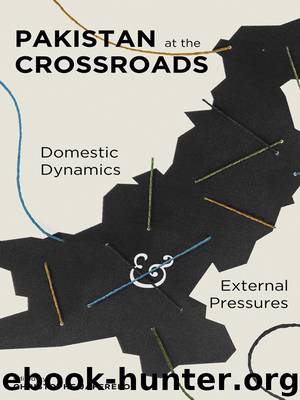Pakistan at the Crossroads by Christophe Jaffrelot

Author:Christophe Jaffrelot
Language: eng
Format: epub
Tags: POL035000, Political Science/Political Freedom and Security/General, POL054000, Political Science/World/Asian
Publisher: Columbia University Press
Published: 2016-04-11T16:00:00+00:00
PAKISTAN’S POLITICAL ECONOMY, 1947–2008
When Pakistan achieved independence, it did not have the capacities of a functioning state. That was not the case for India, which could simply take over central institutions from the British Raj. They inherited a well-developed capital city, a well-staffed central government, a central bank, and a treasury to handle government’s finance. The British left foreign exchange reserves to the partitioned states, 17 percent of which were to be given to Pakistan as its share of these “sterling balances.” Yet none of these were immediately available to Pakistan. It had to create a new state out of nothing. Karachi was chosen as the capital largely because it was the birthplace of Mohammad Ali Jinnah, Pakistan’s founding father, and it had some facilities for housing the government because it was then the capital of Sindh, a province of British India. But Karachi’s “physical plant” was not adequate to accommodate a national government. It was for this reason that the decision was taken to maintain the military establishment in the garrison town of Rawalpindi a thousand miles to the north, from where the British had run their “northern command.” This separation of the civilian and military capitals was to profoundly affect the country’s political and economic development. It took the new government almost a year before a central bank was established in Karachi; Jinnah, as governor-general, inaugurated the new State Bank of Pakistan on July 1, 1948, a few weeks before he died. Even then, India did not deliver Pakistan’s share of the sterling balances; it took a trip to New Delhi by Prime Minister Liaquat Ali Khan and intervention by Mountbatten and Gandhi, before the Indian government released the reserves Pakistan was owed.
Compounding these problems was the arrival of eight million refugees from India, while six million Hindus and Sikhs emigrated to India. At the time of Partition, the provinces that became Pakistan had a population of thirty million; thus, twenty-four million people had to accommodate eight million immigrants, many of them poor farmers and urban dwellers forced to migrate from eastern Punjab and cities in northern and western India due to the sectarian violence that accompanied Partition.6 In terms of GDP growth, the country initially performed poorly, when the national product increased by only 3 percent a year, close to the rate of increase in population.
Pakistan’s economic performance was transformed under General Ayub Khan. In the “development decade” of the 1960s, a number of Western scholars regarded the country as the model of economic development that could be followed by other developing countries.7 During Ayub Khan’s eleven years in power, GDP increased at an average annual rate of 6.7 percent, with the economy more than doubling during this period. The inequitable distribution of the fruits of development would, however, lead by the end of the decade to resurgent Bengali nationalism against the central state, the 1971 war, and the independence of Bangladesh.
In addition to bringing political stability, Ayub Khan’s approach to economic management had a number of salutary features that enabled economic growth.
Download
This site does not store any files on its server. We only index and link to content provided by other sites. Please contact the content providers to delete copyright contents if any and email us, we'll remove relevant links or contents immediately.
| Africa | Americas |
| Arctic & Antarctica | Asia |
| Australia & Oceania | Europe |
| Middle East | Russia |
| United States | World |
| Ancient Civilizations | Military |
| Historical Study & Educational Resources |
The Sympathizer by Viet Thanh Nguyen(4098)
The Rape of Nanking by Iris Chang(4025)
World without end by Ken Follett(3347)
Ants Among Elephants by Sujatha Gidla(3282)
Blood and Sand by Alex Von Tunzelmann(3060)
Japanese Design by Patricia J. Graham(3006)
City of Djinns: a year in Delhi by William Dalrymple(2438)
Foreign Devils on the Silk Road: The Search for the Lost Treasures of Central Asia by Peter Hopkirk(2389)
Inglorious Empire by Shashi Tharoor(2349)
The Queen of Nothing by Holly Black(2326)
India's Ancient Past by R.S. Sharma(2306)
In Order to Live: A North Korean Girl's Journey to Freedom by Yeonmi Park(2304)
Tokyo by Rob Goss(2295)
India's biggest cover-up by Dhar Anuj(2251)
Tokyo Geek's Guide: Manga, Anime, Gaming, Cosplay, Toys, Idols & More - The Ultimate Guide to Japan's Otaku Culture by Simone Gianni(2244)
The Great Game: On Secret Service in High Asia by Peter Hopkirk(2231)
Goodbye Madame Butterfly(2163)
Batik by Rudolf Smend(2010)
Living Silence in Burma by Christina Fink(1988)
